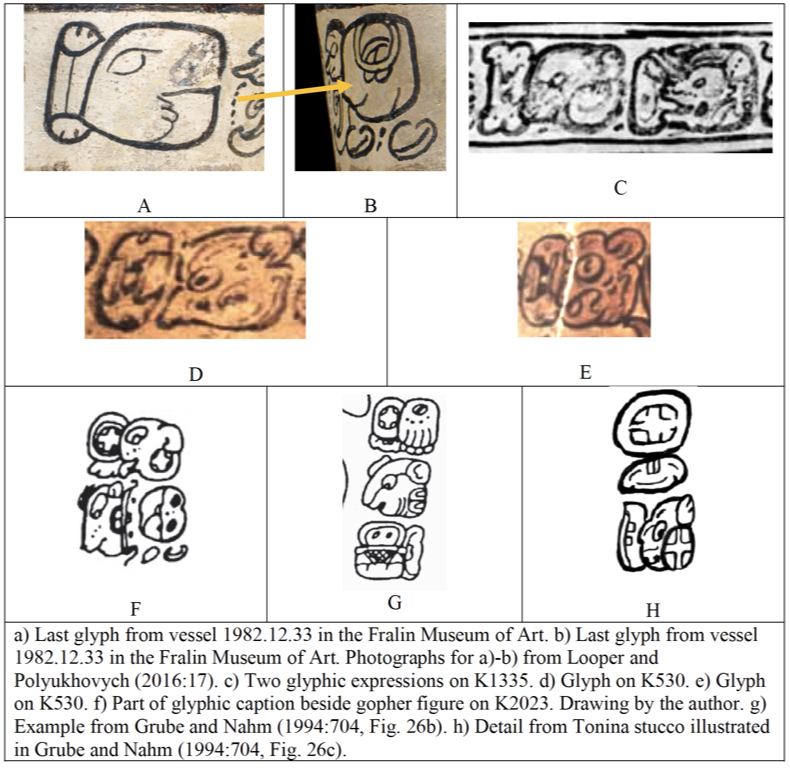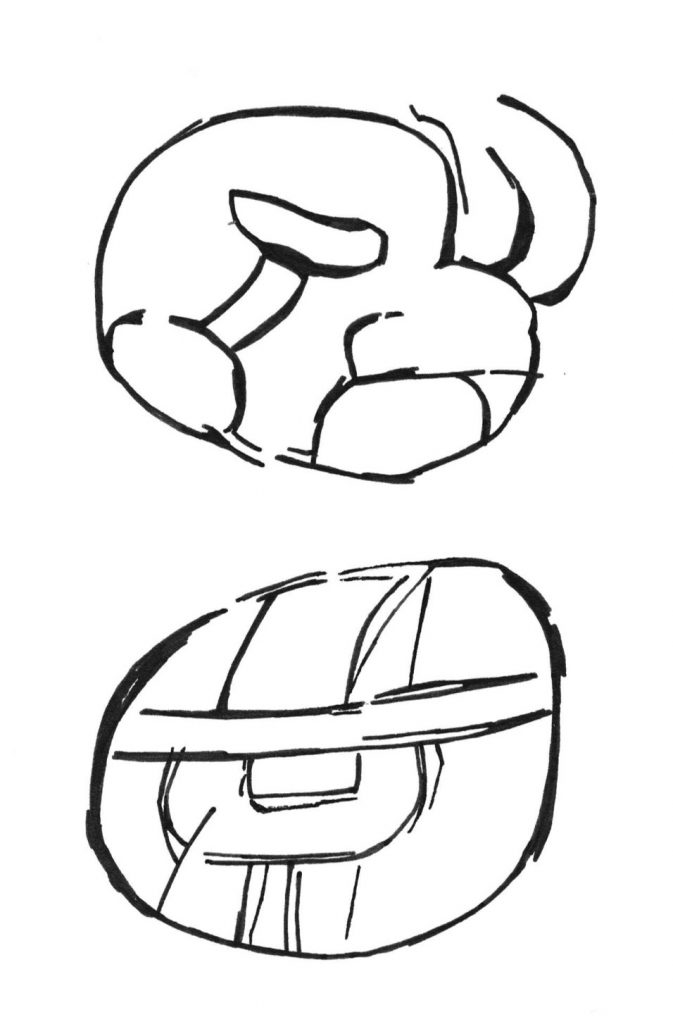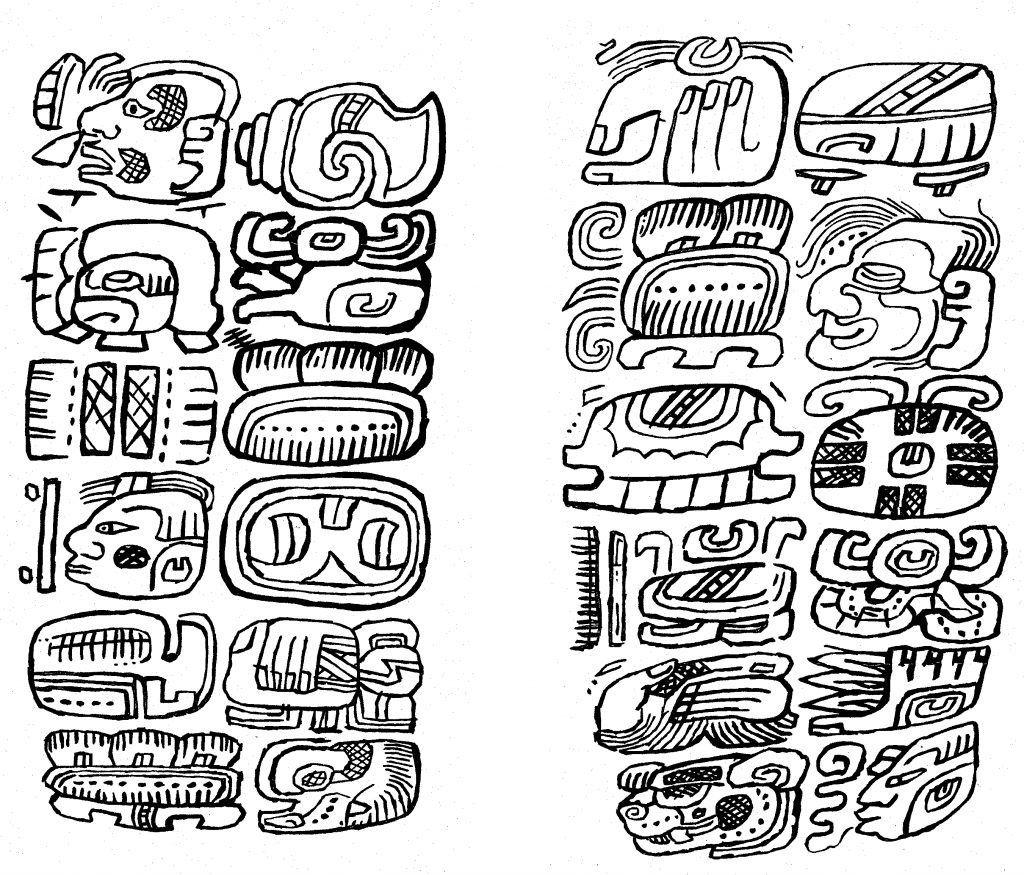A Rare Graphic Convergence and Other Interesting Matters Involving the CHAK-ch’o-k(o) ‘Great Youth’ Collocation
David F. Mora-Marín
davidmm@unc.edu
University of North Carolina
Chapel Hill
7/21/20
This note pertains to a pattern of graphic convergence experienced by T109 in the context of the CHAK-ch’o-k(o) collocation, especially as used in texts on pottery vessels.[i] I will focus on the collocation itself, and the possible causes for the process of convergence.[ii] I also present evidence for the use of T758a ch’o as an iconic logogram CH’OHOK for ch’ohok ‘mouse’, and via rebus logography, as a symbolic logogram CH’OK (or CVC syllabogram ch’ok) used to spell ch’ok ‘unripe; youth’ without a need for T110 ko.
First, some background regarding the signs to be discussed here is needed. The CHAK-ch’o-k(o) collocation was arbitrarily designated as “Rodent Bone” (Figure 1A) by Coe (1973:21-22). The collocation was spelled most frequently as T109.758a:110 in Thompson’s (1962) catalog codes, or 1B9.APB:1BA in Macri and Looper’s (2003) catalog codes. T109/1B9 (Figure 1B) has the logographic value CHAK for Proto-Ch’olan *chäk (~ chächäk) ‘red’ as well as <chac> ‘muy o mucho; gran(de); grave (very, a lot; great; grave)’ based on Colonial Yucatec sources. T758a/APB has the syllabographic value ch’o (Figures 1C-D)[iii]: it depicts the head of a mouse or rat, a fact that explains its value through acrophonic derivation based on a reflex of Proto-Mayan *ch’o7h ‘mouse, rat’ (Kaufman with Justeson 2003:589) or Proto-Ch’olan *ch’ohok ‘mouse’ (Kaufman and Norman 1984:119).[iv] T110/1BA has the syllabographic value ko (Figure 1E) (Grube and Stuart 1987). Note that Thompson’s exemplar for T758a (misleadingly) incorporates a graphically infixed T110 ko in the ear, whereas Macri and Looper’s (2003) and Macri and Vail’s (2009) exemplars do not. T109/1B9 was argued by Grube and Stuart (1987:1) to be iconically based on a long bone, but those authors rejected Thompson’s (1962:51) identification of T110 as a bone. T111/579 or HH1 (Figure 1F) is also a BONE sign, as observed by Grube and Stuart (1987:1), only this one has a reading that is based more directly on its iconic motivation: B’AK for Proto-Ch’olan *b’ak ‘bone’ (< Proto-Mayan *b’aaq). I return to the matter of the iconicity of T110 below. Interestingly, Stuart (1987) demonstrated the substitutional equivalence between T109/1B9 CHAK and a sign depicting a jawbone, not classified by Thompson (1962) but classified by Macri and Looper (2003) as HJ2. This sign is rare, and does not play a role in the CHAK-ch’o-k(o) collocation, thus far, but is nonetheless related to some of the other signs, and is thus included in this note. Together, ch’o-ko was read independently by several epigraphers as ‘youth’ or ‘offspring’ or ‘sprout’ (MacLeod 1990:405). I will use the Proto-Ch’olan gloss ‘unripe; youth’, though in the contexts at hand ‘youth’ will suffice. Last, I should note that there is an allogram with the value CHAK, hence CHAK2, possibly used only in the context of the CHAK-ch’o-k(o) collocation, described and nicknamed LEAF.HEAD by Boot (2009). This sign does not have any bearing to the present discussion.
Figure 1

Figures 2A-C show the typical spelling of this collocation: T109.758a:110 CHAK-ch’o-ko.[v] In such typical examples, T109 in one of its variations (T109a for Figure 2A; T109c for Figures 2B-C), will be characterized by an elongated shape with two black (or cross-hatched) stripes that run along the short axis (cyan color) and two knob-like elements placed at the ends of the sign along the long axis (magenta color), as seen in Figure 2D. And in such typical examples, T110 has two black (or cross-hatched) stripes that run along the long axis of the sign (cyan color), as well as two knob-like elements placed at the ends of the sign that run along the long axis (magenta color), as seen in Figure 2E. Nevertheless, there are three examples (Figures 2F-H), at least, where what should be T109 resembles or is identical to T110. I propose this is the result of graphic convergence or assimilation due to close proximity of two signs that were already graphically similar to begin with. In fact, this convergence does not occur outside of this context, whenever T109 and T110 do not occur in close proximity. This is thus a rare phenomenon indeed. And it raises some questions.
Figure 2

The first question pertains to the example in Figure 2H: the example shows T110—functioning as T109 CHAK—but there is no T110 ko after T758a ch’o. Previously, I suggested that graphic convergence was the result of close proximity. This example would appear to contradict such a suggestion, for there is no T110 following T758a ch’o. Nevertheless, there are special circumstances that require elaboration. For one, as seen in Figure 3A, the collocation in question is immediately followed by the Initial Sign that begins the text seen in Figure 3B. Thus, it is possible that the scribe simply ran out of room to paint the closing T110 ko. In addition, there is evidence that T758b could represent ch’ok ‘youth’ on its own, so that a closing T110 ko could have been unnecessary, and the high frequency of co-occurrence of T109 and T110 within the same collocation would have been sufficient for the scribe to render T109 as T110 in the appropriate context. As seen in Figure 3C, the T109.758a collocation on K1335 was not constrained by space—it is not at the end of the text, but followed by the ke-KELEM expression. And yet, T758a is not followed by T110 ko; it would seem that the scribe spelled simply CHAK-ch’o instead of CHAK-ch’o-k(o), as was the case with the example in Figure 3A, only in this case it was not due to running out of space. I return to the obvious fact that T109 in this example resembles a bone below. For now I would like to highlight a few instances that suggest that T758a did not require the use of T110 ko to spell ch’ok ‘youth’. Figures 3D-E show two expressions present on K530, both spelling T109.758a. The first one, on Figure 3D, appears at the end of the PSS-style text painted along the rim of the vessel, while the second one, on Figure 3E, appears in the middle of a secondary text. Thus, while the scribe may have ran out of room for the first one, the same cannot be true of the second one. More to the point, the passages on Figures 3F-G, described in a previous blog post dealing with the iconographic details of the T757 GOPHER sign (Mora-Marín 2020), seem to use T758a to refer to the k’an-al b’ah‘yellow pocket gopher’ as a type of ‘mouse’, perhaps more generally ‘rodent’; this usage was optional, as its absence from the case in Figure 3H demonstrates. This means that T758a was likely functioning here logographically, to spell a reflex of Proto-Mayan *ch’o7h ‘mouse, rat’ or Proto-Ch’olan *ch’ohok ‘mouse’. Either would account for the acrophonic derivation of its syllabographic value, ch’o. But only one, *ch’ohok, can explain—via rebus—its use in cases like Figures 3A and 3C-E: T758a had a logographic value CH’OHOK for ‘mouse’ and as a result of such value could be used via rebus as CH’OK to represent ch’ok ‘youth’.
Figure 3

The second question raised by the examples of graphic convergence has to do with the nature of the similarity: I have argued that the process of convergence resulting in T109 shifting to resemble or become identical to T110 was facilitated by an initial graphic similarity, but could there be more to the story? The evidence I provide next will support an affirmative answer to this question, and suggest that the initial graphic similarity between T109 and T110 is iconographically motivated: both signs depict long bones. Earlier I noted that Grube and Stuart (1987:1) had identified both T109 and T111 as BONE signs, iconographically speaking, but rejected such an identification for T110. More precisely, they state (Grube and Stuart 1987:1):
The affix in question […] is numbered 110 in Thompson’s glyph catalog (1962:51), and nicknamed “bone.” Visually, however, sign T110 does not appear to be related to representations of bones in Maya art. Indeed, there are two other signs known to represent longbones-affix T111 (and its main sign form T570), read logographically as BAK (“bone” or “captive”); and T109, the well known [sic] sign for CHAK (“red”) […]. In the Palenque Emblem Glyph, T570 is often replaced by a realistic depiction of an animal or bird skull, which reinforces the formal identification of T570 and T110 as bones (Stuart 1985). While T110 at first glance seems to be similar to T111 and T109, it is clearly distinguished graphically in the script and never occurs in the same context as those others. Therefore, the “bone” designation should not be applied to sign T110.
While I agree with their assessment that T110 “is clearly distinguished graphically in the script and never occurs in the same context as the others,” the same is true for T109 CHAK and T111 B’AK, which those authors consider to be depictions of bones: T109 does not occur in the same contexts as T111, and vice versa. Therefore this is not a valid criterion to invalidate the possibility that T110 could be another BONE sign. It should be clear by now that Mayan scribes sometimes used signs with the similar iconographic motivations but could assign them different values and functions: HJ2 represents a jawbone, and so does T590/HJ1, but the former is read CHAK, the latter cho. I agree with Thompson’s assessment of T110 as a BONE sign.
Back to T109: as was seen in Figure 3C, partially reproduced here for convenience as Figure 4A, T109 was rendered so as to resemble a long bone, while retaining the diagnostic parallel black stripes. This confirms the proposal that T109 depicts a long bone. And there is further support: previously, Stuart (1987) had discovered a variant of T109 in the shape of a jawbone that substitutes for T109 in the spelling of the name of one of Tikal’s rulers, Chak Tok(al) Yihch’ak, as seen in Figures 4B-C. Thus, an association with bones—perhaps bones covered in red pigment—is apparent. Another example of this iconographic association is seen in the spellings of ‘puma’: Figures 4D-G show the spellings of chäk b’ahläm ‘puma’ as CHAK(-ka)-B’ALAM (Figures 4D-E), CHAK:ka-B’ALAM (Figure 4F), and CHAK-B’ALAM (Figure 4G). The first two examples show T25 ka functioning as a phonetic complement to CHAK ‘red’, the third shows a conflation of CHAK and ka, and the fourth shows a version of T109 that resembles a long bone, very much like that in Figure 4A. There is even one example that suggests that the parallel black (or cross-hatched) stripes were not needed: Figure 4H shows a glyph BONE-mu-ti-l(a), spelling the name of an avian effigy vessel, reddish in color (Fields and Reents-Budet 2005), perhaps as chak muutil ‘red bird’. So far I lack similarly depictive examples for T110 that would confirm its identity as a BONE sign. There is one Late Preclassic inscription on an Olmec-style jade maskette at the Brooklyn Museum of Art where a sign strongly resembling T110 ko (note parallel bands oriented along the long axis of the sign) resembles a long bone, as seen in Figure 4I. Although its function in this glyphic collocation is unclear for now, there is no reason to doubt for now that T110 depicts a bone, just like T109 does. If so, perhaps their shared iconographic motivation, which could account for similar overall shape, facilitated the process of graphic convergence, in addition to their frequenty co-occurrence in the same collocation.
Figure 4

To conclude, there is an additional context where T109 and T110 may have converged graphically: on K9112 one finds the spelling ko-to-ko (Figure 5A) as part of the nominal phrase referring to the intended owner of a vase. Given the similarity of the graphic composition (i.e. ko.to:ko) to the common collocation CHAK.ch’o:k(o) (Figure 5B) it is possible that the scribe may have rendered what was supposed to be an instance of T109 sign like the T110 sign. If so, perhaps the spelling rendered corresponds to CHAK-to-k(o) for (chä)chäk tok ‘red cloud’.
Figure 5

[i] This research evolved out of my study of Primary Standard Sequence texts described in my FAMSI report from 2004 (Mora-Marín 2004). I initially circulated a printout on this topic at the Texas Meetings in 2005, but neglected to write it up for publication afterward. I have also been utilizing this example in my class lectures since then.
[ii] For previous research on paleography and processes such as graphic divergence and convergence, I would recommend Lacadena (1995) and Mora-Marín (2003, 2016).
[iii] T758a/APB was independently deciphered as ch’o by Stephen Houston, William Ringle, Nikolai Grube, and Barbara MacLeod (MacLeod 1990:354).
[iv] The T287/HE5 ch’o allogram is of no relevance to this note; neither is the T/HJ3 ko allogram.
[v] All “K” numbers refer to vessels phographed by Justin Kerr and available http://research.mayavase.com/kerrmaya.html.
References
Boot, Erik. 2009. A New Sign for CHAK. Rijswijk, the Netherlands. July 21, 2009. URL: http://www.mayavase.com/CHAK-sign.pdf.
Coe, Michael D. 1973. The Maya Scribe and His World. New York: The Grolier Group.
Grube, Nikolai, and Werner Nahm. 1994. A Census of Xibalba: A Complete Inventory of “Way” Characters on Maya Ceramics. In The Maya Vase Book: A Corpus of Rollout Photographs of Maya Vases, edited by Justin Kerr, pp. 686–715. New York: Kerr Associates.
Grube, Nikolai, and David S. Stuart. 1987. Observations on T110 as the Syllable ko. Research Reports on Ancient Maya Writing 8:1-13.
Kaufman, Terrence, with John Justeson. 2003. Preliminary Mayan Etymological Dictionary. http://www.famsi.org/reports/01051/index.html.
Kaufman, Terrence, and William Norman. 1984. An outline of Proto-Cholan phonology, morphology, and vocabulary. In Phoneticism in Maya Hieroglyphic Writing, edited by John S. Justeson and Lyle Campbell, pp. 77-166. Institute for Mesoamerican Studies Publication No. 9. Albany: State University of New York.
Lacadena García-Gallo, Alfonso. 1995. Evolución formal de las grafías escriturarias mayas: implicaciones históricas y culturales. Ph.D. Dissertation, Universidad Complutense de Madrid.
Looper, Matthew, and Yuriy Polyukhovych. 2016. Codex-style Inscribed Vessels in the Fralin Museum of Art. Glyph Dwellers 44. URL: http://glyphdwellers.com/pdf/R44.pdf.
MacLeod, Barbara. 1990. Deciphering the Primary Standard Sequence. Unpublished Ph.D. dissertation. University of Texas at Austin.
Macri, Martha J., and Matthew Looper. 2003. The New Catalog of Maya Hieroglyphs. Volume One: The Classic Period Inscriptions. Norman: University of Oklahoma Press.
Macri, Martha J., and Gabrielle Vail. 2009. The New Catalog of Maya Hieroglyphs. Volume Two: The Codical Texts. Norman: University of Oklahoma Press.
Mora-Marín, David F. 2003. The origin of Mayan syllabograms and orthographic conventions. Written Language and Literacy 6. 193–237.
—–. 2004. The Primary Standard Sequence: Database Compilation, Grammatical Analysis, and Primary Documentation, with Addenda: Description of Digital Database of PSS Texts & Database of PSS Texts. URL: http://www.famsi.org/reports/02047/index.html.
—–. 2008. Full Phonetic Complementation, Semantic Classifiers, and Semantic Determinatives in Ancient Mayan Hieroglyphic Writing. Ancient Mesoamerica 19:195-213.
—–. 2016. A Study in Mayan Paleography: The History of T168/2M1a ʔAJAW ‘Lord, Ruler’ and the Origin of the Syllabogram T130/2S2 wa. Written Language and Literacy 19:1-58.
—–. 2020. Mayan T757/AP9, the “Gopher” Sign, and Its Iconographic Counterpart in Epi-Olmec/Isthmian Writing. Notes on Mesoamerican Epigraphy and Linguistics 2. URL: https://davidmm.web.unc.edu/2020/07/11/note-2/.
Stuart, David. 1987. A Variant of the chak Sign. Research Reports on Ancient Maya Writing 10:1-2.
Thompson, Eric J. 1962. A Catalogue of Maya Hieroglyphics. Norman: University of Oklahoma Press.









